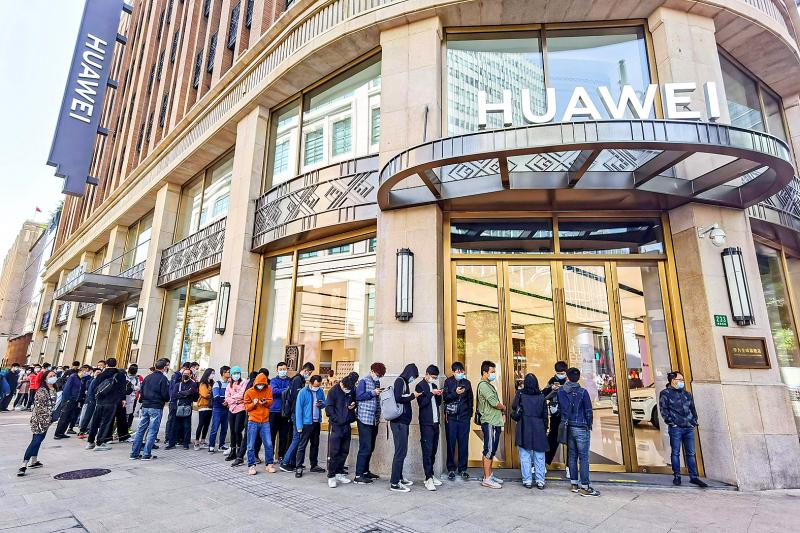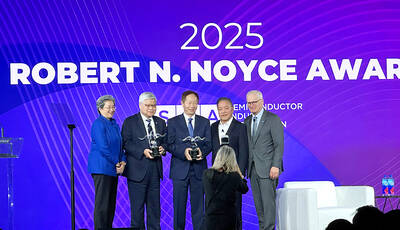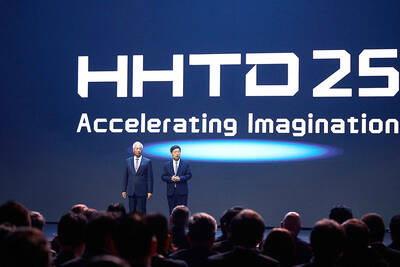Huawei Technologies Co (華為) on Thursday unveiled the Mate 40 smartphone series, potentially its last major release powered by its self-designed Kirin chips.
China’s biggest technology company by sales has been stockpiling chips to get its signature device out in time to compete with Apple Inc’s iPhone 12 over the holidays.
Huawei would then have to overhaul its smartphone lineup after US sanctions that took effect last month curtail its ability to design and manufacture advanced in-house chips by cutting it off from the likes of chipmaker Taiwan Semiconductor Manufacturing Co (台積電).

Photo: AFP
Huawei’s consumer devices group, led by Richard Yu (余承東), had already been prevented from shipping handsets with the full Google-augmented Android experience, but that did not stop it from surpassing Samsung Electronics Co to become the world’s best-selling smartphone maker in the summer, largely on the strength of growing domestic sales.
Without a contractor to produce its own chips or the ability to buy processors from a supplier such as Qualcomm Inc, prognostications for the division’s future are less rosy.
“We are suffering from the US government’s third-round ban. This unfair ban,” Yu said in a livestreamed presentation, adding that the sanctions make things extremely difficult.
However, he did open the event by saying that “at Huawei, we continue to dare to dream for a bright future together.”
Huawei’s third-quarter revenue growth slowed to 3.7 percent as the sanctions exacted a toll on the consumer business, of which the Mate series is the showpiece.
Revenue in the first nine months of the year was up 9.9 percent year-on-year and its net profit margin for the period was 8 percent, compared with 9.2 percent for the first half.
US sanctions against shipments to Huawei took effect last month, cutting off the supply of vital semiconductors and other equipment needed to make its smartphones and servers.
The 6.5-inch Mate 40 and 6.76-inch Mate 40 Pro feature the 5-nanometer Kirin 9000 processor, second to Apple’s A14 chip to offer that advanced manufacturing node in consumer devices.
The system-on-chip contains 15.3 billion transistors, including eight central processing unit cores maxing out at a speed of 3.13 gigahertz, and 24 graphic processing unit cores that Huawei claims give it 52 percent faster graphics than Qualcomm’s best offering.
Both devices have sloping glass sides and in-display fingerprint sensors.
The new rear “Space Ring” design accommodating Huawei’s multi-camera system is reminiscent of the control wheel of the iPod.
It has a 50-megapixel main camera accompanied by zoom and ultrawide lenses.
Although prevented from doing business with technological partners and suppliers, Huawei still touts Leica co-branding on its imaging hardware and is once again offering a Porsche Design edition of its new flagship smartphone.
The company also announced a new pair of over-ear headphones and new home speakers in collaboration with French audio brand Devialet SA.
Huawei is the market leader in China, where the mobile software ecosystem is fleshed out with vendor-specific apps and stores, alongside a reliance on Tencent Holdings Ltd’s (騰訊) WeChat as a mini operating system.
The Mate 40 gives Huawei a response to Apple’s new 5G-enabled iPhones and extends the period of time before it has to completely rethink its consumer devices strategy.
The Mate 40 is to go on sale for 899 euros (US$1,064), the Mate 40 Pro for 1,199 euros and a Mate 40 Pro Plus with further upgrades for 1,399 euros, although the company did not specify a release date.

Shiina Ito has had fewer Chinese customers at her Tokyo jewelry shop since Beijing issued a travel warning in the wake of a diplomatic spat, but she said she was not concerned. A souring of Tokyo-Beijing relations this month, following remarks by Japanese Prime Minister Sanae Takaichi about Taiwan, has fueled concerns about the impact on the ritzy boutiques, noodle joints and hotels where holidaymakers spend their cash. However, businesses in Tokyo largely shrugged off any anxiety. “Since there are fewer Chinese customers, it’s become a bit easier for Japanese shoppers to visit, so our sales haven’t really dropped,” Ito

The number of Taiwanese working in the US rose to a record high of 137,000 last year, driven largely by Taiwan Semiconductor Manufacturing Co’s (TSMC, 台積電) rapid overseas expansion, according to government data released yesterday. A total of 666,000 Taiwanese nationals were employed abroad last year, an increase of 45,000 from 2023 and the highest level since the COVID-19 pandemic, data from the Directorate-General of Budget, Accounting and Statistics (DGBAS) showed. Overseas employment had steadily increased between 2009 and 2019, peaking at 739,000, before plunging to 319,000 in 2021 amid US-China trade tensions, global supply chain shifts, reshoring by Taiwanese companies and

Taiwan Semiconductor Manufacturing Co (TSMC) Chairman C.C. Wei (魏哲家) and the company’s former chairman, Mark Liu (劉德音), both received the Robert N. Noyce Award -- the semiconductor industry’s highest honor -- in San Jose, California, on Thursday (local time). Speaking at the award event, Liu, who retired last year, expressed gratitude to his wife, his dissertation advisor at the University of California, Berkeley, his supervisors at AT&T Bell Laboratories -- where he worked on optical fiber communication systems before joining TSMC, TSMC partners, and industry colleagues. Liu said that working alongside TSMC

TECHNOLOGY DAY: The Taiwanese firm is also setting up a joint venture with Alphabet Inc on robots and plans to establish a firm in Japan to produce Model A EVs Manufacturing giant Hon Hai Precision Industry Co (鴻海精密) yesterday announced a collaboration with ChatGPT developer OpenAI to build next-generation artificial intelligence (AI) infrastructure and strengthen its local supply chain in the US to accelerate the deployment of advanced AI systems. Building such an infrastructure in the US is crucial for strengthening local supply chains and supporting the US in maintaining its leading position in the AI domain, Hon Hai said in a statement. Through the collaboration, OpenAI would share its insights into emerging hardware needs in the AI industry with Hon Hai to support the company’s design and development work, as well